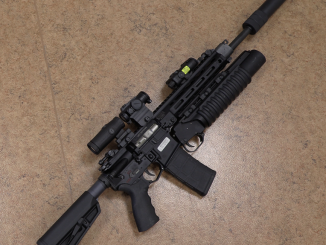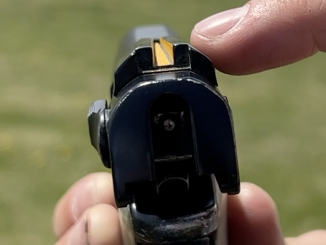RIA’s catalog page for this rifle
This is a Model 1923 Thompson Autoloading Rifle, one of a batch of 20 made by Colt for US military testing in 1924. The system is designed on the same basic Blish principle as the Thompsons submachine gun; the idea that two sliding surfaces will lock solidly together under enough pressure, and not begin to slide until the pressure drops below a certain level. In reality, both guns are simply delayed blowback, and the rifle (in .30-06) suffered from very high extraction pressures. So high, that ejected cases were reportedly sticking in a wood board at the 1924 trial.
Versions of the Thompson rifle would continue to receive military testing until 1929, and one broke a bolt in an endurance test and was pulled out for the final time. This particular rifle is a bit of an interesting anomaly in that it has a lightweight rifle barrel and a detachable magazine. In theory, the Model 1923 included a rifle version with a fixed internal magazine and a light machine gun versions with this rifle’s type of detachable magazine but also a heavy barrel and a folding bipod.




The reason the rifles were manufactured by Colt is probably just because Colt was already making the Model 1921 Thompson SMG for Auto-Ordnance under contract. They would later make the M1928 model as an extension of that agreement. Since Colt was already making guns for Auto Ordnance, Thompson having them make a prototype run of these rifles would be fairly simple as a matter of business.
As for the length and proportions of the rifle, they closely resemble those of the Mannlicher series of self-loading rifles, the 1891 and 1893. The ’91 model used a recoiling barrel, but the ’93 operated on a very similar retarded-blowback system with a fixed barrel and a rotating bolt. In fact, W.H.B. Smith, in his book Mannlicher Rifles and Pistols (Stackpole 1947) specifically refers to the ’93 as a forerunner of the Blish system.
(NB; It’s back in print now, in an omnibus edition along with Smith’s books on Mauser and Walther rifles and pistols.)
You can also read a bit about the various Mannlicher self-loading rifle designs here;
https://www.riflemagazine.com/magazine/PDF/ri3partial.pdf
In an article written in 1969 by Maj. George Nonte, and including several drawings from Smith’s book.
cheers
eon
The HK91 (delayed blow back roller locked breech) was notorious for throwing ejected cases so far it was joked that a shooter could cover his own right flank. On one occasion my HK threw a casing that stuck mouth first like a dart in a wooden post 3 feet away.
Featured on pages 74-75 of Tracie Hill’s “The Ulimate Thompson Book” by Colllector Grade. With little additional detail.
And described there as a model 1921.
BSA in the UK produced some of these rifles during the period in which they had a business partnership with Auto-Ordnance. They didn’t manage to sell any though. I wonder how rare the BSA models are now – the production run can’t have been very big.
45-70k USD? Great googly moogly
One question i have was this hammer or striker fired?
Do the side projections on the magazine contain oil soaked pads for helping
extraction.?
I often wonder if chamber fluting would have helped this design and the Pederson.
The one-off experimental Thompson SMG-based SAW in .30-06 had oiler pads attached to its modified BAR magazines that looked almost exactly like the additions on this one. So it’s a good bet that these are oiler pad housings as well.
cheers
eon
Delayed action guns all suffer “Slow Extraction” which empty cases are pushed out of the chamber still having rather high pressure inside in a time interval that bigger than locked breech samples and therefore, needing precautions to prevent sticking inside the chamber walls. Longitudinal groves connecting with rifled bore sections are usefull for this purpose as creating a floating media between empty case and chamber. ln this rifle it looks that the case being different which Blish Lock indeed works as a lock rather than a delaying instrument but functioning in a very limited time and releasing the empty case having still very high pressure inside with a backward speed nearly being equal with straight blowback push out and any friction preventing measures would get this event even worse. lMHO.
As Ian noted, this works on blowback delayed by mechanical disadvantage – specifically, accelerating the mass of the rear bolt at a disadvantage proportional to the angles of the mating surfaces. Had they recognized this, and rebalanced the bolt masses accordingly (by starting the cam path in the ejection port, for instance) it might have worked a lot better. It would be interesting to apply this idea to a lighter-recoiling rifle cartridge; it might make a good AR upper project.
https://forum.guns.ru/forummessage/36/2787406.html
Atlanta FINALLY!!! a catalog of foreign submachine guns is published from the collection of the Military Historical Museum of Artillery, Engineering and Signal Corps. The author is the curator of the fund of foreign weapons of the N.A. Ovodkov is the author of a number of articles on the history of weapons, with which the local audience is already familiar.
We prepared and typeset this catalog for a long time, but everything worked out and it was published. In my opinion, on this topic in the specified museum is an exhaustive source. We tried to make it also beautiful and showing the insides of the most, in our opinion, interesting samples – just for the local gourmets!
Here is a link to the publisher’s website for this book.
https://www.atlant-tpg.ru/product/foreign-submachine-guns-to-sob/